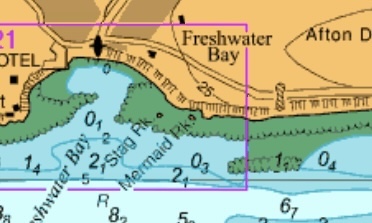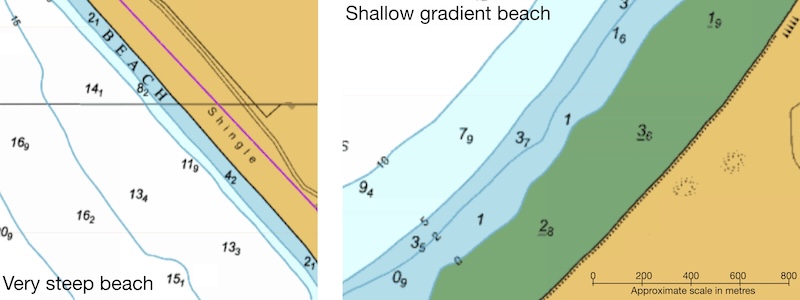3.7 Environmental considerations
3.7.1 Reefs and gravel bars
We’ve seen how shallows cause waves to break. This doesn’t just happen at a beach - any shallow area in the sea can cause breaking waves. Isolated shallow areas can cause waves to break very suddenly. As a result, paddling in waves when there are reefs, gravel bars or isolated rocks can be ‘exciting’ or ‘dangerous’ depending on the wave size.
Charts can often be used to identify areas with shallows over which waves can break.

Extract of chart for Freshwater Bay, Isle of Wight (UKHO, not for navigation). Charts are often useful in identifying areas of shallows and reefs, such as those shown around both sides of the Bay and to the east of the bay, below the Obelisk. Note that there is a large area of the chart beyond the drying areas where depths are less than a meter.
OS maps also show areas between high and low tide, but will not show shallow areas below the low water mark.
3.7.2 Rouge waves
All the waves you encounter on a given day will not be the same! Some will be larger than others!
Remember that a wave forecast will normally give the ‘significant wave height’ - the average height of the largest third of the waves. Whilst this measure gives a good idea of how big the waves feel, around 15% of waves will equal or exceed this height and it’s possible to encounter occasional waves of twice the significant wave height.
Occasional larger waves can cause us a number of issues:
Larger waves will break over shallower reefs - so a reef that we don’t know is there because most waves don’t break over it can suddenly become dangerous. Look out for waves that steepen but don’t break, and consider staying away from places where this occurs.
Rocky landings can be tricky even with normal sized waves, and might be significantly disrupted if a few big waves appear. Watch the landing spot for a few minutes before committing to it.
Rockhopping through gaps, caves, gullies etc is great fun, but many moves will become more dangerous and challenging in larger waves. Observe for some time before committing to a particular move, and keep an eye out to sea in case larger waves start coming in.
3.7.3 Dumping surf
Remember that on steep beaches, the waves plunge or collapse straight onto the beach, creating a ‘dumping’ wave. These can break powerfully onto a kayak, pin a swimmer to the beach, and possibly pull them under the wave and away from the beach in the undertow that these waves create. Launching from such beaches can be difficult. Landing on beaches with dumping surf creates an obvious hazard, in that it’s hard to see the dumping wave from offshore, and you may end up in a situation where you don’t have an alternative option for a landing at the end of the day.
Dumping wave on steep stony beach. Fortunately, this wave isn’t too big, making launching awkward rather than dangerous
Beaches with shallow gradients typically have a long distance between the waterline at high water and low water. So while they might form nice safe surf, there can be along distance to carry the boat if you happen to be there at low tide. This may enable you to identify shallow angled beaches from a chart or a large scale OS map - look for a large green drying area on the chart. Steeper beaches can be recognised on the chart by the water becoming deep close offshore.

Steep and shallow gradient beaches shown on charts at the same scale. Note that the steep beach shows no drying area and the depth increases to 10m within about 100m of the shoreline. By contrast, the shallow gradient beach has a large drying area (shown in green) beyond which the depth increases gradually.
Sometimes the steepness of a beach can vary with the height of the tide. This is worth watching out for - a beach that has a shallow angled lower part and a steeper upper part might be easy to launch from at low tide, but present a nightmare landing spot with dumping waves at high tide.
Note that beaches with dumping surf tend not to feature on surf forecasts - they’re not good places for surfers. This can make it difficult to assess likely conditions before you get the beach.